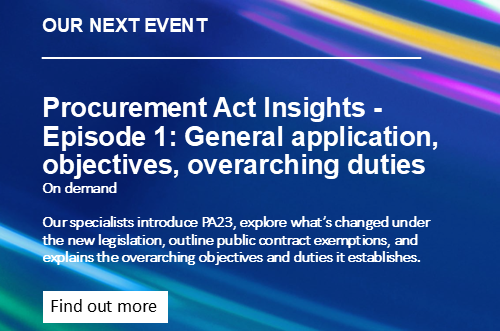- Details
The LADs are Alright
 Laura Campbell discusses liquidated damages in construction contracts, focussing upon the long-running Triple Point saga which ended in the Supreme Court this year.
Laura Campbell discusses liquidated damages in construction contracts, focussing upon the long-running Triple Point saga which ended in the Supreme Court this year.Earlier this year when I did a short session on liquidated damages for the Sharpe Pritchard Coffee Club, I left attendees with a cliff hanger: what was the Supreme Court ultimately going to decide about the application of liquidated damages upon termination of a contract? Liquidated damages are commonplace in construction contracts as a remedy for delay, so the long running Triple Point saga which started in the Technology and Construction Court (TCC) in 2018[1] and ended in the Supreme Court this year[2], has been of much interest to the construction industry.
As a reminder of the facts of the case, Triple Point (the Contractor) and PTT entered into a contract under which Triple Point was to provide software and software implementation services to PTT. The works were divided into two phases, and Triple Point was to be paid in instalments on completion of certain milestones. The contract contained a liquidated damages clause which provided:
If [Triple Point] fails to deliver work within the time specified and the delay has not been introduced by PTT, [Triple Point] shall be liable to pay the penalty at the rate of 0.1% of undelivered work per day of delay from the due date for delivery up to the date PTT accepts such work. (Emphasis added)
The phase 1 works were completed late, but PTT accepted those works and paid Triple Point. However, PTT refused to pay invoices relating to phase 2 as the relevant milestones had not been reached. Triple Point suspended work and left site because of non-payment, which PTT considered a repudiatory breach and so terminated the contract.
In the TCC, Triple Point claimed payment on the unpaid invoices, and PTT counterclaimed for liquidated damages for delays up to the point of termination of the contract. Triple Point’s claim was dismissed, and PTT was awarded liquidated damages for delays incurred prior to termination, on the basis that the liquidated damages clause applied to both phases up to the point of termination.
Things then took an interesting turn in the Court of Appeal, where it was decided[3] that the phrase “up to the date PTT accepts such work” meant that the clause did not apply in circumstances where Triple Point did not complete (and so PTT could not accept) the works. Accordingly, the court found that PTT was not entitled to liquidated damages for the phase 2 works which had not been completed or accepted.
The decision was considered unorthodox as it did not take a common-sense approach to the application of liquidated damages in commercial contracts. The judgment had (unhelpfully) put forward three options in the circumstances:
- The liquidated damages clause did not apply at all in relation to delay in provision of the services;
- The liquidated damages clause applied only up to the point at which the contract was terminated; or
- The liquidated damages clause applied until the services were completed by a second contractor.
Sir Rupert Jackson decided that any of the three options above could apply, and it would depend on the drafting of the clause as to which category it would in fact fall into. The decision was, in essence, based on a contractual interpretation approach rather than a commercial common-sense approach. This lack of a clear solution to the issue left the door open for the Supreme Court to make a decision, and to thankfully give some clarity on the matter. It handed down its decision on 16 July 2021 and our initial analysis of the decision is available here.
To the delight of those of us who work for ‘employer’ clients, the Supreme Court took a commercial common-sense approach: it decided that liquidated damages would not accrue after a contract terminated unless there was an express contractual provision to the contrary (as this would demonstrate that this was the intention of the parties when they entered the contract). The overall view of the Supreme Court was that the Court of Appeal had placed too much emphasis on a 1913 case[4], which did not consider the application of liquidated damages in a scenario such as this (where the contractor did not finish providing the services), and so the Supreme Court had little sympathy for its application.
With this good news and a conclusion to the matter, we have picked out a couple of pearls of wisdom from the judges in the Supreme Court and highlighted why these are pertinent to public sector construction contracts:
- Including liquidated damages clauses saves time and money for public sector projects where budgets and resources are limited. The judgment tells us that liquidated damages clauses are used in construction contracts, “to provide a remedy that is predictable and certain for a particular event […]. The employer does not then have to quantify its loss, which may be difficult and time consuming to do”[5].Liquidated damages are used commonly as a remedy for delay in construction contracts and many of the standard form construction contracts (including the JCT and NEC suites) provide for this as industry standard. In the public sector, where time and money are precious, agreeing liquidated damages at the outset as a means of managing losses resulting from delay is imperative. It is much more time and cost effective to set this out in the contract than to spend valuable time and public funds arguing with a contractor after the event.
- Liquidated damages give cost certainty so are of benefit to both parties. The judgment discussed the use of liquidated damages as a means of avoiding the difficulties of having to quantify a claim for delay. One of the judges stated that “such a clause limits the contractor’s exposure to liability of an otherwise unknown and open-ended kind, while at the same time giving the employer certainty about the amount that it will be entitled to recover as compensation. Each party is therefore better able to manage the risk of delay in the completion of the project.”
Anybody who regularly works on construction contracts knows that lengthy negotiations can take place before a contract is concluded. It seems sensible, therefore, to negotiate the inclusion of a clear liquidated damages clause, as it gives certainty to both parties as to the amount that will be due to the employer if the contractor causes a delay to the completion of the works. This is beneficial for public sector contracts as the rate of liquidated damages will reflect what the employer has calculated as a genuine estimate of the losses that they are likely to incur as a result of any delay. It is clear to the contractor from the outset that this remedy is available to the employer, so gives them certainty as to their financial exposure for delay (and this limits their liability for general (unliquidated) damages to some extent). As liquidated damages clauses act as a deterrent against delay, contractors can avoid their application by working to time on a project. This is also a benefit to the employer because they know that they have the entitlement to levy liquidated damages at a pre-determined rate to cover their losses caused by delay.
As well as these pearls of wisdom from the judges, here are a few additional tips on the use of liquidated damages clauses in construction contracts:
- Ensure that the clause includes a figure and, if there is not an agreed figure, you should refer to £0 so that you are not precluded from making a claim for general damages.
- If you have agreed anything with the contractor about the application of liquidated damages – such as a liquidated damages ‘holiday’, or a stepped approach whereby the rates increase if the delay continues, or a cap on the amount which can accrue (the last of which we suggest avoiding if at all possible!) – ensure that the drafting captures the agreed position so that it is expressly included in the contract. In the event of a dispute, matters agreed verbally or by email which are not formally included in the contract will not be taken into consideration.
- When you have a liquidated damages clause, the rate which is included is (or at least should aim to be!) a genuine pre-determined estimate of the losses that the employer is likely to incur for a delay to the completion of the works. Ensure that this is considered on a commercial basis, taking into account all of the losses which may arise out of a delay. It is prudent to work this out against an itemised list of such costs and their daily/weekly rates, so that you have these calculations to hand in the event that the contractor claims the rates are unfair.
- The rates included are a commercial decision for the employer. Once they are agreed and included in the contract the courts are reluctant to intervene, especially where the parties are sophisticated commercial entities that have had the benefit of legal advice.
- Ensure that you comply with any provisions in your contract for applying liquidated damages. There may be notice provisions that you need to observe and timescales that you need to work to. If these are a condition precedent for levying liquidated damages, the contractor will have an easy defence against a claim if you have not served the correct notices and adhered to timescales.
In conclusion, liquidated damages are commonplace in construction contracts to deal with the financial consequences of delays. They are also discussed regularly by the courts as a number of issues arise in relation to the operation of the clauses in practice. The decision of the Supreme Court in Triple Point has brought welcome clarity following the confusion created by the Court of Appeal, and confirmed the accepted position that liquidated damages are recoverable for delay prior to termination whether or not the works are complete.
[1] Triple Point Technology vs PTT Public Company Limited [2018] EWHC 45 (TCC)
[2] Triple Point Technology Inc v PTT Public Co Ltd [2021] UKSC 29
[3] Triple Point Technology Inc v PTT Public Co Ltd [2019] EWCA Civ 230
[4] Glanzstoff (British Glanzstoff Manufacturing Co Ltd v General Accident, Fire and Life Assurance Co Ltd, 1913 SC (HL) 1
[5] Paragraph 35 of the judgment in the Supreme Court
Laura Campbell is an Associate at Sharpe Pritchard LLP.
For further insight and resources on local government legal issues from Sharpe Pritchard, please visit the SharpeEdge page by clicking on the banner below.
This article is for general awareness only and does not constitute legal or professional advice. The law may have changed since this page was first published. If you would like further advice and assistance in relation to any issue raised in this article, please contact us by telephone or email
|
Click here to view our archived articles or search below.
|
|
ABOUT SHARPE PRITCHARD
We are a national firm of public law specialists, serving local authorities, other public sector organisations and registered social landlords, as well as commercial clients and the third sector. Our team advises on a wide range of public law matters, spanning electoral law, procurement, construction, infrastructure, data protection and information law, planning and dispute resolution, to name a few key specialisms. All public sector organisations have a route to instruct us through the various frameworks we are appointed to. To find out more about our services, please click here.
|
|
OUR RECENT ARTICLES
December 10, 2025
Sharpe Pritchard appointed to £60m London Boroughs’ Legal Alliance frameworkSharpe Pritchard, one of the UK’s leading public law firms, has been re-appointed to the London Boroughs’ Legal Alliance (LBLA) Solicitors Panel.
November 20, 2025
Strengthening the standards and conduct framework for local authorities in EnglandJames Berry offers his insight into how the proposed changes to standards and conduct rules will affect local authorities.
November 04, 2025
Procuring and operating open frameworks under the Procurement Act 2023Chantelle Pink offers advice to authorities on open frameworks and how to procure them.
October 31, 2025
Building Solar – 5 Top Tips for Solar Farm Construction ContractsSolar farm construction contracts are in focus following fascinating insights into the continuing global uptake and expansion of renewables, and particularly solar, within the 2025 mid-year report of Ember, a global energy think tank.
|
|
OUR KEY LOCAL GOVERNMENT CONTACTS
|
||
|
Partner 020 7406 4600 Find out more |
||
|
Partner 020 7406 4600 Find out more |
||
|
Rachel Murray-Smith Partner 020 7406 4600 Find out more |







 Catherine Newman
Catherine Newman
